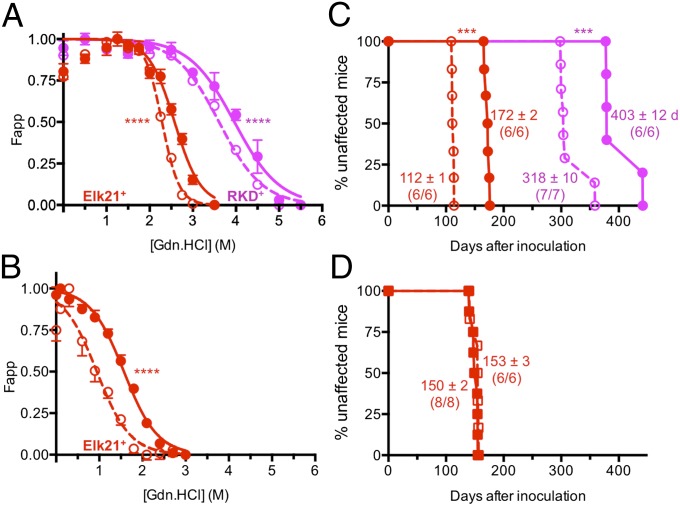Fig. 4.
Quinacrine alters the conformation of elk and deer PrPSc and the transmission properties of elk CWD prions. (A) Conformational stability of elk PrPSc in Elk21+ treated with 1 μg/mL quinacrine (solid line, filled red symbols) or untreated (dashed line, open red symbols) for 6 d (n = 16), assessed by C-CSA. RKD+ were treated with 1 μg/mL quinacrine (sold line, filled magenta symbols) or untreated (dashed line, open magenta symbols) for 60 d (n = 4). (B) Conformational stability of elk PrPSc extracted from Elk21+ treated with 1 μg/mL quinacrine (solid line, filled red symbols) or untreated (dashed line, open red symbols) for 6 d (n = 8), assessed by densitometric analysis of PrPSc applied to dot blots. ****P ≤ 0.0001 refers to differences between GdnHCl1/2 from best-fitted curves. (C) Incubation times of Q-CWD prions are prolonged compared with CWD prions. Times to disease onset in Tg(DeerPrP)1536+/− and Tg(ElkPrP)5037+/− mice (red and magenta lines/symbols, respectively) inoculated with Elk21+ either with 1 μg/mL quinacrine (filled circles) or untreated Elk21+ (open circles). (D) Quinacrine treatment of Tg(ElkPrP)5037+/− mice fails to affect time to onset of CWD. CWD-inoculated Tg(ElkPrP)5037+/− mice orally dosed with quinacrine, filled squares; animals similarly inoculated, but not receiving quinacrine, open squares. ***P ≤ 0.001. Incubation times (mean ± SEM) of the numbers of diseased mice are shown for each transmission.

